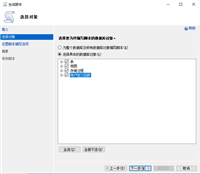ludwig出品,第五行动组,叹号妹
/*
--注意:准备数据(可略过,非常耗时)
create table check1_t1
(
id int,
c1 char(8000)
)
create table check1_t2
(
id int,
c1 char(8000)
)
declare @i int
set @i=1
while @i<=10000
begin
insert into check1_t1 select @i,'c1'
insert into check1_t2 select 10000+@i,'c1'
set @i=@i+1
end
create table check2_t1
(
id int,
c1 char(8000)
)
declare @i int
set @i=1
while @i<=10000
begin
insert into check2_t1 select @i,'c1'
set @i=@i+1
end
insert into check2_t1 values(10001,'c2')
insert into check2_t1 values(10002,'c1')
create table check3_t1
(
id int,
c1 char(7000)
)
create table check3_t2
(
id int,
c1 char(7000)
)
declare @i int
set @i=1
while @i<=20000
begin
if @i%2 =0
begin
insert into check3_t1 select @i,'c1'
end
else
begin
insert into check3_t1 select @i,'c2'
end
if @i%100=0
begin
insert into check3_t2 select @i,'c1'
insert into check3_t2 select @i+50000,'c2'
end
set @i=@i+1
end
create table check4_t1
(
id int,
c1 char(500),
)
declare @i int
set @i=1
while @i<=500000
begin
if @i%100000 =0
begin
insert into check4_t1 select @i,'c2'
end
else
begin
insert into check4_t1 select @i,'c1'
end
set @i=@i+1
end
create nonclustered index ncix_c1 on check4_t1(c1)
create table check5_t1
(
id int,
c1 char(10),
)
declare @i int
set @i=1
while @i<=10000
begin
insert into check5_t1 select @i,'c1'
if @i%2=0
begin
insert into check5_t1 select @i,'c1'
end
set @i=@i+1
end
*/
--=====================================
--1、 union all 代替 union
dbcc dropcleanbuffers
dbcc freeproccache
--测试一:(26s) 执行计划:表扫描->排序->合并联接
select id,c1 from check1_t1 --1w条数据
union
select id,c1 from check1_t2 --1w条数据
--测试二: (4s) 执行计划:表扫描->表扫描串联
select id,c1 from check1_t1 --1w条数据
union all
select id,c1 from check1_t2 --1w条数据
--总结:测试一中的union 排序和去重合并是相当耗时的,如果不要此功能,大数据时最好加上all
--=====================================
--2、 exists 代替 count(*)
dbcc dropcleanbuffers
dbcc freeproccache
----测试一: (7s) 执行计划:表扫描-> 流聚合-> 计算矢量
declare @count int
select @count=count(*) from check2_t1 where c1='c1' --1w条数据
if @count>0
begin
print 's'
end
----测试二: (0s) 执行计划:常量扫描/表扫描-> 嵌套循环-> 计算标量
if exists(select 1 from check2_t1 where c1='c1') --1w条数据
begin
print 's'
end
--总结:判断是否存在,用exist即可,没必要用count(*)将表的所有记录统计出来,扫描一次
--=====================================
--3、 in(select col1 from table)的代替方式
dbcc dropcleanbuffers
dbcc freeproccache
--测试一: (3s)执行计划:表扫描 -> 哈希匹配
select id,c1 from check3_t2 --400行
where id in (select id from check3_t1 where c1='c1') --2w行
--测试二:(1s)执行计划:表扫描-> 并行度 -> 位图 -> 排序 -> 合并联接 -> 并行度
select a.id,a.c1 from check3_t2 a
inner join check3_t1 b on a.id=b.id where b.c1='c1'
--测试三:(3s)执行计划:表扫描-> 哈希匹配
select a.id,a.c1 from check3_t2 a
where exists (select 1 from check3_t1 b where b.id=a.id and b.c1='c1')
--总结:能用inner join 尽量用它,sql server在查询时会将关联表进行优化
--=====================================
--4、 not exists 代替 not in
--测试一:(8s) 执行计划:表扫描-> 嵌套循环 -> 哈希匹配
select id,c1 from check3_t1 --2w行
where id not in (select id from check3_t2 where c1='c1') --400行
--测试二:(4s) 执行计划:表扫描-> 哈希匹配
select a.id,a.c1 from check3_t1 a
where not exists (select 1 from check3_t2 b where b.id=a.id and b.c1='c1')
--总结:尽量不使用not in ,因为会调用嵌套循环,建议使用not exists代替not in
--=====================================
--5、 避免在条件列上使用任何函数
drop table check4_t1
create nonclustered index ncix_c1 on check4_t1(c1) --加上非聚集索引
---测试一:(4s)执行计划: 索引扫描
select * from check4_t1 where rtrim(c1)='c2'
---测试二:(0s)执行计划: 索引查找
select * from check4_t1 where c1='c2'
--总结:where条件里对索引字段使用了函数,会使索引查找变成索引扫描,从而查询效率大幅下降
--=====================================
--6、 用sp_executesql执行动态sql
dbcc dropcleanbuffers
dbcc freeproccache
create proc up_check5_t1 (
@id int
)
as
set nocount on
declare @count int,
@sql nvarchar(4000)
set @sql = 'select @count=count(*) from check5_t1 where id = @id'
exec sp_executesql @sql,
n'@count int output, @id int',
@count output,
@id
print @count
create proc up_check5_t2 (
@id int
)
as
set nocount on
declare @sql nvarchar(4000)
set @sql = 'declare @count int;select @count=count(*) from check5_t1 where id = ' + cast(@id as varchar(10)) + ';print @count'
exec(@sql)
---测试一:瞬时
declare @n int
set @n=1
while @n<=1000
begin
exec up_check5_t1 @n
set @n=@n+1
end
---测试二:2s
declare @n int
set @n=1
while @n<=1000
begin
exec up_check5_t2 @n
set @n=@n+1
end
create clustered index cix_id on check5_t1(id)
dbcc dropcleanbuffers
dbcc freeproccache
--查看缓存计划
select a.size_in_bytes '占用字节数',
total_elapsed_time / execution_count '平均时间',
total_logical_reads / execution_count '逻辑读',
usecounts '重用次数',
substring(d.text, (statement_start_offset / 2) + 1, ((case statement_end_offset
when -1 then datalength(text)
else statement_end_offset
end - statement_start_offset) / 2) + 1) '语句'
from sys.dm_exec_cached_plans a
cross apply sys.dm_exec_query_plan(a.plan_handle) c,
sys.dm_exec_query_stats b
cross apply sys.dm_exec_sql_text(b.sql_handle) d
where a.plan_handle = b.plan_handle
order by total_elapsed_time / execution_count desc;
--总结:通过执行下面缓存计划可以看出,第一种完全使用了缓存计划,查询达到了很好的效果;
--而第二种则将缓存计划浪费了,导致缓存很快被占满,这种做法是相当不可取的
--=====================================
--7、 left join 的替代法
--测试一 执行计划:表扫描 -> 哈希匹配
select a.id,a.c1 from check3_t1 a --2w行
left join check3_t2 b on a.id=b.id where b.c1='c1' --400行
--测试二 执行计划:表扫描 -> 哈希匹配
select a.id,a.c1 from check3_t1 a
right join check3_t2 b on a.id=b.id where a.c1='c1'
--测试三 执行计划:表扫描 -> 哈希匹配
select a.id,a.c1 from check3_t1 a
inner join check3_t2 b on a.id=b.id where b.c1='c1'
--总结:三条语句,在执行计划上完全一样,都是走的inner join的计划,
--因为测试一和测试二中,where语句都包含了left 和right表的字段,sqlserver若发现只要有这个表的字段,则会自动按照inner join进行处理
--补充测试:(1s)执行计划:表扫描-> 并行度 -> 位图 -> 排序 -> 合并联接 -> 并行度
select a.id,a.c1 from check3_t2 a --400行
inner join check3_t1 b on a.id=b.id where a.c1='c1' --2w行
--总结:这里有一个比较有趣的地方,若主表和关联表数据差别很大时,走的执行计划走的另一条路
--=====================================
--8、 on(a.id=b.id and a.tag=3)
--测试一
select a.id,a.c1 from check3_t1 a
inner join check3_t2 b on a.id=b.id and a.c1='c1'
--测试二
select a.id,a.c1 from check3_t1 a
inner join check3_t2 b on a.id=b.id where a.c1='c1'
--总结:内连接:无论是左表和右表的筛选条件都可以放到where子句中
--测试一
select a.id,a.c1,b.c1 from check3_t1 a
left join check3_t2 b on a.id=b.id and b.c1='c1'
--测试二
select a.id,a.c1,b.c1 from check3_t1 a
left join check3_t2 b on a.id=b.id where b.c1='c1'
--总结:左外连接:当右表中的过滤条件放入on子句后和where子句后的结果不一样
--=====================================
--9、 赋值给变量,加top 1
--测试一:(3s) 执行计划:表扫描
declare @id int
select @id=id from check1_t1 where c1='c1'
select @id
--测试二:(0s)执行计划:表扫描-> 前几行
declare @id int
select top 1 @id=id from check1_t1 where c1='c1'
select @id
--总结:给变量赋值最好都加上top 1,一从查询效率上增强,二为了准确性,若表check1_t1有多个值,则会取最后一条记录赋给@id
--=====================================
--10、 考虑是否适合用case语句
declare @s int=1
select * from check5_t1
where c1=(case @s when 1 then c1 else 'c2' end)
select * from check5_t1
where @s=1 or c1='c2'
/*--=====================================
、检查语句是否需要distinct. 执行计划:表扫描-> 哈希匹配-> 并行度-> 排序
select distinct c1 from check3_t1
、禁用select *,指定具体列名
select c1 from check4_t1
select * from check4_t1
、insert into table(*),指定具体的列名
、isnull,没有必要的时候不要对字段使用isnull,同样会产生无法有效利用索引的问题,
和避免在筛选列上使用函数同样的原理。
、嵌套子查询,加上查询条件,确保子查询的结果集最小
--=====================================*/
如对本文有疑问,请在下面进行留言讨论,广大热心网友会与你互动!!
点击进行留言回复
相关文章:
-
-
sql某个日期是当年的第几周
/* *周一作为一周的开始 *当年的1月1号所在的周算作第一周 */ CREATE function GetWeekIndexFirstDate ( @...
[阅读全文]
-
-
数据库SQL---范式
1、数据冗余导致的问题:冗余存储、更新异常、插入异常、删除异常。 2、函数依赖:一种完整性约束。 在关系模式r(R)中,α属于R,β属于R。 1)α函数...
[阅读全文]
-
-
数据库SQL---查询
1、查询所有列 select *from emp;--*表示所有的,from emp表示从emp表中查询。 2、查询指定列 select empno,e...
[阅读全文]
-
-
-
-
-

网友评论